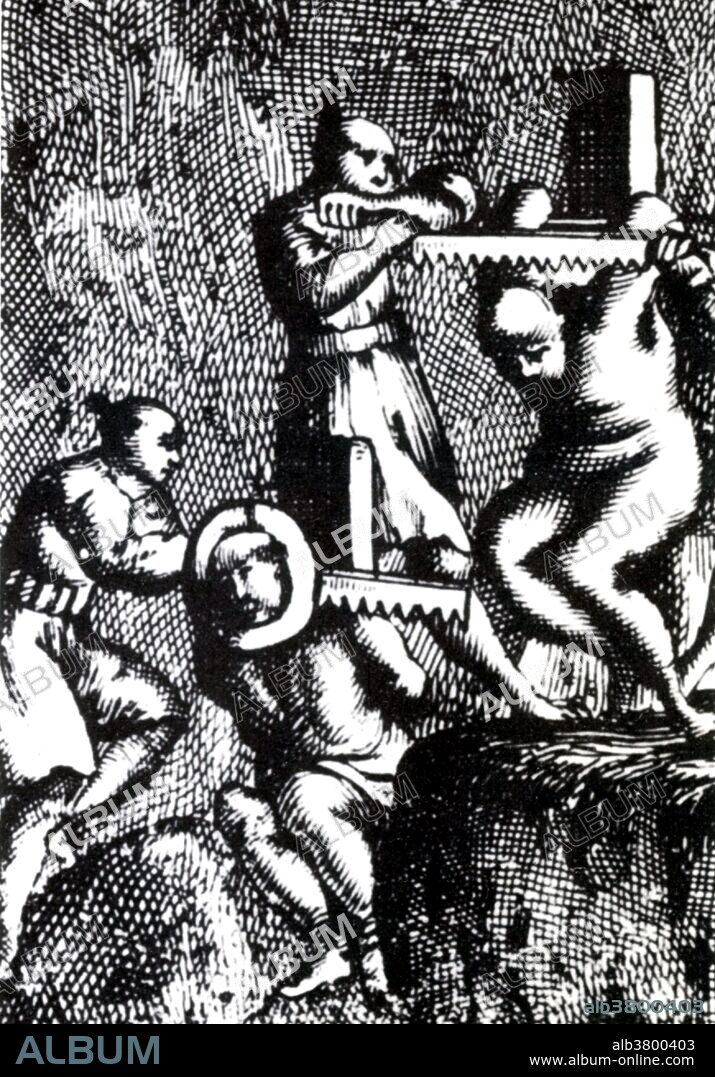alb3800403
Execution, Death by Sawing, 18th Century

|
Añadir a otro lightbox |
|
Añadir a otro lightbox |



¿Ya tienes cuenta? Iniciar sesión
¿No tienes cuenta? Regístrate
Compra esta imagen

Título:
Execution, Death by Sawing, 18th Century
Descripción:
Traducción automática: El término "muerte por aserrado" indica el acto de cortar a una persona viva por la mitad. La mayoría de las veces, la víctima era suspendida boca abajo, de modo que la mayor parte de la sangre se dirigía a la cabeza. Los torturadores serraban la entrepierna de la víctima, de modo que toda la sangre de la cabeza oxigenaba el cerebro para que la víctima no se desmayara como sucedería normalmente bajo un dolor tan insoportable. Por lo general, la sierra alcanzaba el ombligo de la víctima antes de que la inconsciencia se apoderara de ella, a veces hasta el diafragma. En la historia de Simón el Zelote, se describe explícitamente a la persona colgada boca abajo y serrada verticalmente por la mitad, comenzando por la ingle. Se han registrado diferentes métodos de muerte por aserrado. La muerte por aserrado fue un método de ejecución que se utilizó, según se informa, en diferentes partes del mundo. En los casos relacionados con el emperador romano Calígula, se dice que el aserrado se realizó por la mitad. En los casos de Marruecos, se afirma que el aserrado se realizó a lo largo, tanto desde la ingle hacia arriba como desde el cráneo hacia abajo. Grabado holandés de origen desconocido, siglo XVIII
The term "death by sawing" indicates the act of sawing a living person in half. Most often the victim was suspended upside down, most of the blood will go to the head. The torturers would saw into the victim's crotch, all of the blood in the head will oxygenate the brain so that the victim will not pass out as one normally would under such excruciating pain. Typically, the saw would reach the victim's navel before unconsciousness would take hold, sometimes as far as the midriff. In the story about Simon the Zealot, the person is explicitly described as being hung upside-down and sawn apart vertically through the middle, starting at the groin. Different methods of death by sawing have been recorded. Death by sawing was a method of execution reportedly used in different parts of the world. In cases related to the Roman Emperor Caligula, the sawing is said to be through the middle. In the cases of Morocco, it is stated that the sawing was lengthwise, both from the groin and upwards, and from the skull and downwards. Dutch engraving from unknown source, 18th century.
Crédito:
Album / NYPL/Science Source
Autorizaciones:
Modelo: No - Propiedad: No
¿Preguntas relacionadas con los derechos?
¿Preguntas relacionadas con los derechos?
Tamaño imagen:
3140 x 4500 px | 40.4 MB
Tamaño impresión:
26.6 x 38.1 cm | 10.5 x 15.0 in (300 dpi)
Palabras clave:
ARTE • BLANCO Y NEGRO • CASTIGAR • CASTIGO • CRUEL • CRUELDAD • DIBUJO • EJECUCION • GRABADO • HISTORIA • HISTORICO • HOMBRES • ILUSTRACION • OBRA DE ARTE • ORDENAMIENTO JURÍDICO • PERSECUCION • SENTENCIA DE MUERTE • SIGLO XVIII • TORTURADOR • VERDUGO • VICTIMA
 Pinterest
Pinterest Twitter
Twitter Facebook
Facebook Copiar enlace
Copiar enlace Email
Email
